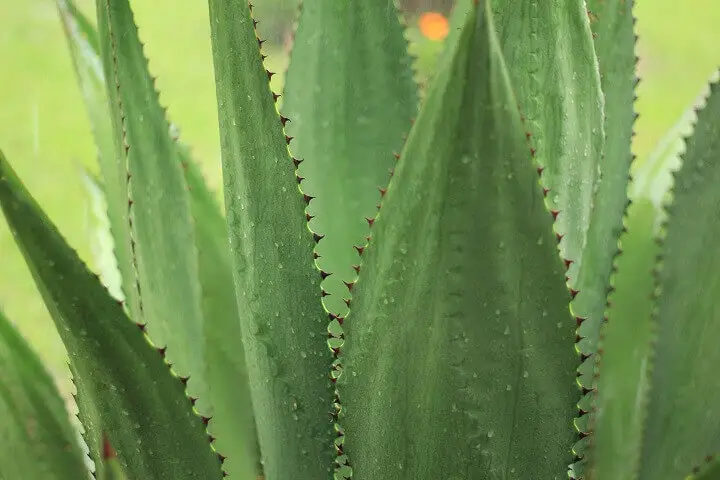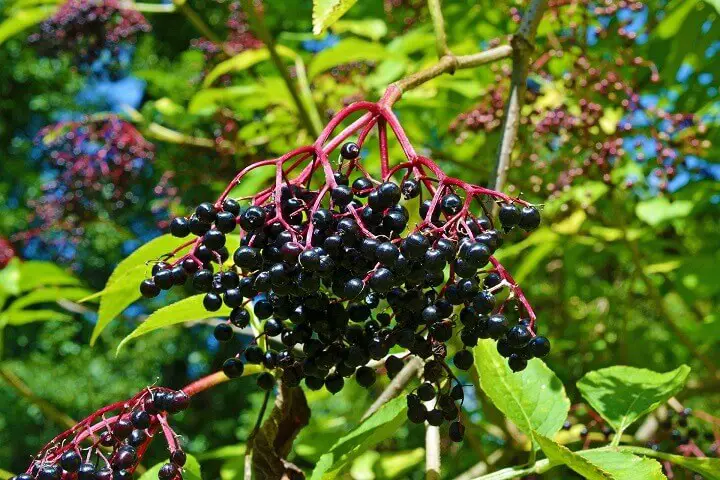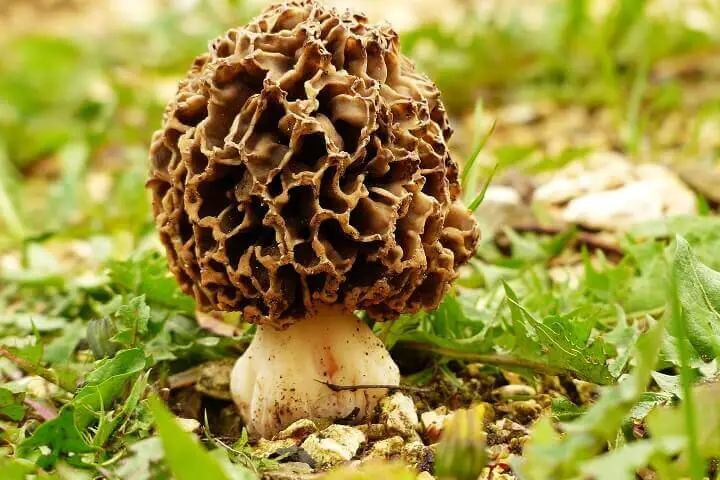Estimated reading time: 16 minutes
No matter your location, North America is one of the most diverse places on earth. The land offers a desert landscape, rainforest, mountainous regions, and midwest plains. Within those landscapes are countless wild edibles that are nutritious, fresh, and unlike anything you have ever tasted. With a lot of research and some bravery, you too can forage for foods in your neck of the woods.
Below is a list of some of the North American wild edibles that surround us. Before eating any wild edibles, consult with a reputable website or book to ensure you are eating non-toxic wild plants. Your recipes will diversify and improve when cooking with wild edibles from your region.
Want to save this post for later? Click Here to Pin It On Pinterest!
List of Wild Edibles in North America
There are thousands of wild edible plants in North America, including trees, lichens, mushrooms, and seaweeds. Here is a list of 25 common and interesting wild edibles that you may have heard of.
Acorns – Quercus alba

As one of the most common wild edible nuts, acorns come from either gambrel or white oak trees. The leaves, flowers, and unripened green acorns are toxic, but the ripened acorns are perfectly healthy to eat. White oak acorns are the sweetest and tastiest of all acorn varieties.
Edible acorns can be found everywhere in North America aside from the west coast. You can dry the acorns for 2-4 weeks before grinding them into flour. The gluten-free flour can then be used to make acorn griddle cakes.
To make the acorn griddle cakes, whisk together 2 cups of acorn flour, 1 egg, a pinch of salt, a pinch of sugar, and some melted butter. A pancake-like batter should form. Ladle the batter into a greased skillet and cook on both sides until golden brown. Serve with maple syrup.
Agave

Found in the southwest and some parts of Florida, the agave plant is edible in its heart, leaves, sap, stalk, and flower. Some species of agave are not edible, so it is important to correctly identify which varieties you find. Cook the agave plant and sap before consuming for the safest practice.
You can roast your agave leaves until golden. Chew on the caramel-like sap before discarding the fibrous material left behind. The sweet caramelized flavor of the roasted leaves is a great treat, as long as the plant is identified carefully.
Asparagus – Asparagus officinalis

Asparagus grows across the entirety of the US and Canada. The deeply-rooted plant can continue growing and producing throughout the warmer months. Young spears that are at least ½-inch in diameter are best to eat. Simply cut the spear at the ground level to harvest. These little veggies can be enjoyed either raw or cooked.
After the spear has matured, it is no longer safe to eat. The red berries that grow after the spear stage are toxic to humans. Only the young spears are edible before maturation.
Blackberry – Rubus

Blackberries come from a perennial shrub that exists in every state in North America. The berries are in season from July-August and should only be harvested when they are mature. Mature berries are deep purple where less mature berries are white or pink. These berries make for fabulous cobblers or are deliciously eaten raw.
Blueberry – Vaccinium uliginosum

These specific blueberries are also referred to as bog or alpine blueberries. They are found all across North America except for the northern plains. The peak picking season lasts from mid-July to late September. The higher the elevation, the sweeter the blueberries will be.
Use your freshly-picked blueberries inside of a blueberry pie. Using your favorite pie crust, fill it with a mixture of 2 cups blueberries, 1 cup sugar, 1 tablespoon lemon juice, and 1 tablespoon cornstarch. Mix with a pinch of salt and bake the pie until bubbly and browned, about 1 hour at 350 degrees Fahrenheit.
Cattail – Typha

Cattails are often found in roadside ditches and wetlands. In the past, they were used medicinally for wound healing, excess bleeding, and kidney function. Cattails can absorb toxins from their surroundings, so be extra careful about where you are harvesting from.
The edible parts of a cattail include its rhizomes, flowers, young shoots, inner shoots, inner hearts, and pollen. ¼ cup of cattail pollen can be mixed with ¾ cups of flour to create a delicious wheat flour mix to bake with.
Related: Cattails – The Little Known Survival Food
Chamomile – Matricaria

These little daisy-like flowers are commonly found in tea. Chamomile is said to have a calming effect with stomach-soothing properties.
If you’d like to make homemade chamomile tea, harvest the flowers and allow them to dry. Measure out 1 teaspoon of dried flowers and add to 1 cup of boiling water. Add rose hips or raspberry leaves and enjoy a cup of warm chamomile tea.
Chanterelle Mushrooms

This fancy mushroom can be found in multiple varieties across North America. There are black, blue, golden, oak, red, white, and winter chanterelle varieties, to name a few. The edible parts include the cap and stem. These mushrooms are delicious if sauteed simply in melted butter with plenty of salt.
Chicken of the Woods – Laetiporus sulphureus

Another mushroom variety, the chicken of the woods is found east of the rocky mountains. The soft, bright yellow edges are edible. When cooked, the mushrooms have the texture and flavor of cooked chicken, hence their name. Many vegans swear by this fungi to create a vegan fried chicken recipe.
For vegan fried chicken, soak your chicken of the woods in buttermilk seasoned with hot sauce. Then, dredge in a mixture of flour, paprika, garlic powder, and cayenne pepper. Deep fry the mushrooms in peanut oil until golden brown and crispy.
Chickweed – Stellaria media

Found in every state, chickweed is found in meadows and on folk’s lawns. The seedpods, flowers, leaves, and stems are all edible. Chickweed can be toxic in very large quantities due to saponins in the plant. Harvest the top few inches of the plant and serve with a salad or on a sandwich.
Chicory – Cichorium intybus

This dark, leafy green is a healthy lettuce-like leaf. Chicory can absorb toxins and pollution from the area around it, so you’ll want to harvest from an unpolluted site. The milky sap inside can cause skin irritation, so eat chicory in moderation.
Cook chicory greens in the same way you would cook other leafy greens. They are delicious sauteed with some garlic and oil. The young leaves are the most tender part of the plant. Wash very well before cooking or consuming.
Dandelions

Those invasive greens and yellow flowers from your front lawn are actually edible! During the Great Depression, dandelion greens were consumed by many families who did not have much money or food. To harvest, cut the leaves at the ground level. Wash 2-3 times to ensure all dirt and sand are cleared from the leaves. Serve raw in a salad.
Related: 8 Things To Do With All Those Dandelions
Elderberry – Sambucus nigra

These little berries can be found on shrubs across the entirety of North America. The fruit and flowers are edible, but only when cooked. Raw elderberries or their leaves can lead to cyanide poisoning if eaten.
These berries are best when cooked into a syrup but boiling them in water, sugar, lemon zest, and lemon juice. Allow the syrup to reduce and then cover and steep for 24 hours. The syrup is delicious when added to cocktails.
Related: How To Make Elderberry Syrup
Fennel

This licorice-flavored bulb is found across the midwest, the east coast, and the west coast. The seeds, fruit, flowers, leaves, above-ground bulb, roots, and stems are all edible on this plant. Fennel is best served raw when shaved into a salad. You can also make soups, stews, and sauces using cooked fennel.
Fiddlehead Ferns

The fiddlehead is the curly, soft top found on ferns found across North America. These curly fiddleheads can be harvested when they are still soft. Many restaurants serve fiddleheads as a delicacy depending on the time of year. Sauteed fiddleheads pair beautifully with red wine and a thick-cut steak.
Gooseberry – Ribes

Found in 48 states, the gooseberry can be found in bogs, swamps, forests, and rocky landscapes. This berry is rich in vitamins and antioxidants. Underripe berries are best for jams, sauces, and pies. Fully ripened gooseberries should be enjoyed raw. Wild gooseberry sauce pairs beautifully with fresh whitefish.
Hops – Humulus lupulus

Ever wanted to harvest hops to make beer? Well, you can! Hops are found in all states except for a few southern states. Young leaves can be eaten raw or cooked with other vegetables. The flower cones are used to brew beer or make tea. Those who are pregnant or dealing with certain cancers should avoid hops. Beware, because hops are also toxic to dogs.
Huckleberry – Gaylussacia

There are 4 varieties of huckleberry found in North America; black, bog, evergreen, and red. The fruits have high levels of vitamins and antioxidants. They are to be harvested as they ripen, and the fruits are the edible part of the plant. The berries can be eaten raw or cooked, depending on preference.
Jerusalem Artichokes – Helianthus tuberosus

The tall, herbaceous perennial yields a yellow flower and has edible roots/tubers. They are found all across the US except for Nevada, Arizona, and New Mexico. These little roots are delicious when roasted.
To make Roasted Jerusalem Artichokes, chop 4 cups of cleaned artichoke roots. Toss with 1 chopped onion, 1 tablespoon of olive oil, and 1 teaspoon of salt. Spread on a baking tray and roast at 350 degrees Fahrenheit for 25-30 minutes. Serve them warm.
Lobster Mushrooms – Hypomyces lactifluorum

Lobster mushrooms, found in most states across the US, resemble a cooked lobster tail. The bright orange-red hue is highly prized and served in specialty restaurants nationwide. The young fruiting body is the edible part of this wild plant.
While these mushrooms are delicious, mature lobster mushrooms can become purple and fishy in odor. Some people have reported feeling ill after consuming these mushrooms, so like with anything, be cautious and consume these in moderation.
Maple Sap – Acer

Who wouldn’t want to make their own maple syrup from scratch? Both the bigleaf and sugar maple varieties produce edible sap for syrup. Bigleaf maple trees are found on the west coast while sugar maples are found on the midwest and east coast.
To make maple syrup, you will need to fill your pot to a depth of at least 1.5 inches with maple sap. Boil at 212 degrees F without stirring. As sap evaporates, add more. Keep the temperature at a constant 212-219 degrees. Then, transfer the syrup to a smaller pan and continue boiling. Once the temperature reaches 226 degrees, remove from the heat. Store in a cool, dry place.
Related: How To Make Maple Syrup Step By Step
Milkweed – Asclepias syriaca

A perennial that grows from the eastern US to Oregon, milkweed commonly grows in ditches and gardens. You can eat the young shoots under 6 inches, newly opened leaves, flowers, seedpods, and seeds. Milkweed needs to be cooked before you can eat it.
Older leaves may be poisonous if consumed in large amounts, so beware. Milkweed must be cooked in multiple changes of water before eating, but the result can replace broccoli or asparagus in some recipes.
Morel Mushrooms – Morchella

As one of the fanciest, most renowned mushrooms in North America, the morel is a delicacy. There are many varieties including black morels, blushing, common, and thick-stemmed. The different types of morels can be found all across the nation. Morels are delicious when thoroughly cooked in a cream sauce or deep-fried. They are not to be eaten raw.
False morels and early morels are common poisonous look-alikes. If you are foraging for mushrooms, it is recommended to have a mushroom expert accompany you. Mushrooms are one of the hardest plants to correctly identify. You do not want your fun afternoon of foraging to turn into a health nightmare.
Plaintain – Plantago

Not to be confused with the starchy banana-like fruit, North American plantain is a perennial with silky, hairy flower stems. The leaves and seeds are completely edible and can be used in salads or be added to pesto. The leaves are great when sauteed or used like spinach. This stuff is found in every single state across the US.
You can also use plantain seeds as a field laxative. Steep a small handful of seeds in boiling water for 10-15 minutes. Drink the tea, swallowing some of the seeds. Be sure to hydrate very well when taking field laxatives.
Related: The Miracle of Plantain Weeds – 9 Amazing Uses
Prickly Pear Cactus – Opuntia ficus-indica

Found in the southwest and southeast, prickly pear cactus is a desert-dwelling succulent. They are thick, pear-shaped pads with spikes. Both the pads and fruits are edible on this plant. The fruits can be harvested in late summer and eaten raw. The pads are better when sliced and cooked. Topical uses include the treatment of wounds and burns in the field.
To make grilled prickly pear cactus, slice 6 pads with the needles removed. Coat in 1 tablespoon of oil, some salt, and some sugar to taste. Grill on either side for 5-6 minutes or until completely tender. Serve with a squeeze of lime juice.
Conclusion
The world around us offers an abundance of wild edibles. The North American landscape is full of beautiful, lush foliage, much of which is edible. If you choose to cook from wild edibles, be absolutely sure of the plants you are foraging.
Educate yourself in the local flora and fauna and before you know it, you will have created a unique dish from simple ingredients found right outside your home.
Like this post? Don't Forget to Pin It On Pinterest!











